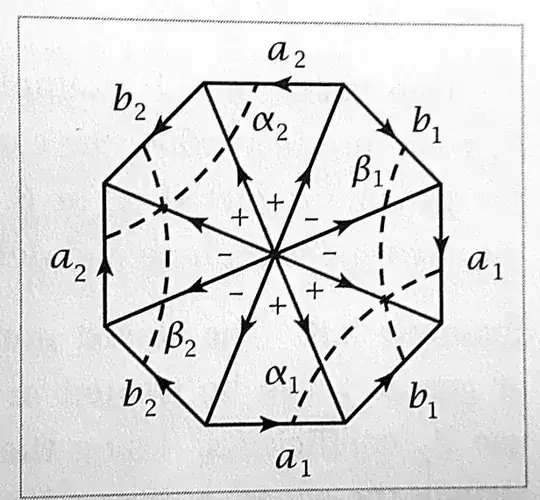Edit: I realise that your concern is about why $\psi_1 \smile \phi_1$ is does not appear to be equal to $ - \phi_1 \smile \psi_1$. My original answer didn't address this point directly, so let me address it:
The statement $\psi_1 \smile \phi_1 = - \phi_1 \smile \psi_1$ is only true when we view $\psi_1 \smile \phi_1$ and $- \phi_1 \smile \psi_1$ as functions on the homology classes in $H_2(X, \mathbb Z)$. It does not hold at the level of individual 2-chains. (The proof in Hatcher uses a chain homotopy argument, which is only valid at the level of homology.)
In the context of this particular example, this means there is no reason why $\psi_1 \smile \psi_1(\sigma)$ should be equal to $- \psi_1 \smile \phi_1(\sigma)$ when $\sigma$ represents a single triangle in the diagram. However, if $s$ represents a generator of $H_2(X, \mathbb Z)$ (so $s$ is a sum of all eight triangles in the diagram), then the equality $\psi_1 \smile \phi_1(s) = - \phi_1 \smile \psi_1 (s)$ must hold.
Let's check this. With the vertex numbering as stated in the book (see also my original answer below, where I've spelt out the choice of numbering), $\phi_1 \smile \psi_1 (s)$ receives a contribution of $1$ from the bottom-right triangle, and no contributions from any other triangle. Meanwhile $\psi_1 \smile \phi_1(s)$ receives no contribution from the bottom-right triangle; however, it receives a contribution of $-1$ from the right-hand triangle, which means that $\psi_1 \smile \phi_1 (s) = -1$. So everything works out.
Original answer: (Addressing the issue of renumbering of vertices, which is a major source of confusion here, but turns out not to be what motivated the question.)
Singular homology/cohomology
Hatcher's ultimate goal is to compute the action of $\phi_1 \smile \psi_1$ on a generator of $H_2(X,\mathbb Z)$. As a representative of the generator of $H_2(X, \mathbb Z)$, he uses the sum of the eight triangles shown in the diagram. The interesting thing is that only certain choices of vertex numbering will ensure that the singular 2-chain formed by summing the eight triangles has zero boundary.
So why is this? In singular homology, the boundary of $[0,1,2]$ is $[0,1] + [1,2] - [0,2]$, whereas the boundary of $[2,0,1]$ is $[0,1] - [2,1] + [2,0]$. These are different singular $1$-chains! In the definition of singular homology, there is no explicit provision for identifying $[2,1]$ as the same as $-[1,2]$, or for identifying $[2,0]$ as the same as $-[0,2]$. Therefore, when we number the vertices on our eight triangles, we must take care that the boundaries really do cancel out, bearing in mind that $[i,j]$ is not explicitly declared equal to $-[j,i]$ in the group of singular 1-chains.
One numbering that works is to take the "centre" vertex to be the $0$ vertex of each of the eight triangles. The triangles marked "$+$" (resp. "$-$") then have vertices $1$ and $2$ assigned in an anti-clockwise (resp. clockwise) fashion, and are weighted with coefficients of $+1$ (resp. $-1$). You can easily verify that this numbering ensures that the boundary of the sum of the eight triangles is zero. With this choice of numbering, the only triangle that contributes to the action of $\phi_1 \smile \psi_1$ is the bottom-right triangle, and this triangle contributes a value of $1$.
Simplicial homology/cohomology
What's different here is that $[i,j]$ is usually defined to be the same as $-[j,i]$ in simplicial homology. This gives you the flexibility to number your vertices however you like, without needing to worry about proper cancellations of boundaries. Unfortunately, this causes annoying ambiguities when you evaluate cup products.
This math.SE question discusses this issue. In particular, see Jim Belk's answer, in which he proposes the symmetrised definition
$$ \phi_1 \smile \psi_1 ([0,1,2]) = \frac 1 {3!} \sum_{\sigma \in S_3}(-1)^\sigma \phi_1([\sigma(0), \sigma(1)]). \psi_1([\sigma(1), \sigma(2)]).$$
With this definition, you will find that the bottom-right triangle contributes only $\frac 1 2 $ to action of the cup product; however, the right-hand triangle contributes the remaining $\frac 1 2 $, ensuring that the action of the cup product on the generator of $H_2(X, \mathbb Z)$ is $1$.


